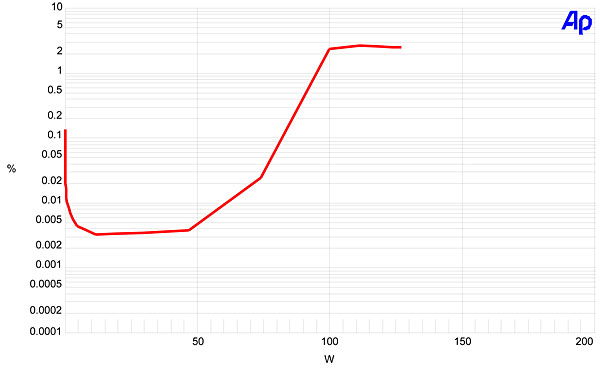Yamaha RX-V371 A/V receiver HT Labs Measures
Five channels driven continuously into 8-ohm loads:
0.1% distortion at 32.4 watts
1% distortion at 35.1 watts
Analog frequency response in Stereo Bypass mode:
–0.61 dB at 10 Hz
–0.17 dB at 20 Hz
–0.01 dB at 20 kHz
–2.84 dB at 50 kHz.
Analog frequency response with stereo signal processing:
–0.98 dB at 10 Hz
–0.27 dB at 20 Hz
–0.25 dB at 20 kHz
–63.22 dB at 50 kHz.

This graph shows that the RX-V371's left channel, from Audio1 input to speaker output with two channels driving 8-ohm loads, reaches 0.1% distortion at 81.9 watts and 1% distortion at 95.3 watts. Into 4 ohms, the amplifier reaches 0.1% distortion at 100.6 watts and 1% distortion at 121.1 watts.
There was no analog multichannel input to measure. THD+N from the Audio1 input to the speaker output was less than 0.010% at 1 kHz when driving 2.83 volts into an 8-ohm load. Crosstalk at 1 kHz driving 2.83 volts into an 8-ohm load was –76.34 dB left to right and –75.63 dB right to left. The signal-to-noise ratio with an 8-ohm load from 10 Hz to 24 kHz with "A" weighting was –107.30 dBrA.
From the Dolby Digital input to the speaker output, the left channel measures –0.20 dB at 20 Hz and –0.21 dB at 20 kHz. The center channel measures –0.20 dB at 20 Hz and –0.26 dB at 20 kHz, and the left surround channel measures –0.19 dB at 20 Hz and –0.13 dB at 20 kHz. From the Dolby Digital input to the line-level output, the LFE channel is +0.09 dB at 20 Hz when referenced to the level at 40 Hz and reaches the upper 3-dB down point at 94 Hz and the upper 6-dB down point at 116 Hz.—MJP
Video Test Bench
| 3:2 HD | 2:2 HD | MA HD | 3:2 SD | 2:2 SD | MA SD | VIDEO CLIPPING | LUMA RESOLUTION | CHROMA RESOLUTION | SCALING | |
| DIGITAL | N/A | N/A | N/A | N/A | N/A | N/A | PASS | PASS | PASS | N/A |
| ANALOG | N/A | N/A | N/A | N/A | N/A | N/A | N/A | N/A | N/A | N/A |
The Yamaha performs no video processing. Its video circuitry is pass-through only (resolution in = resolution out). It also does not cross-convert from a component input to an HDMI output. But it cleanly passed a 1080p HDMI input through to a 1080p output.—TJN





























































